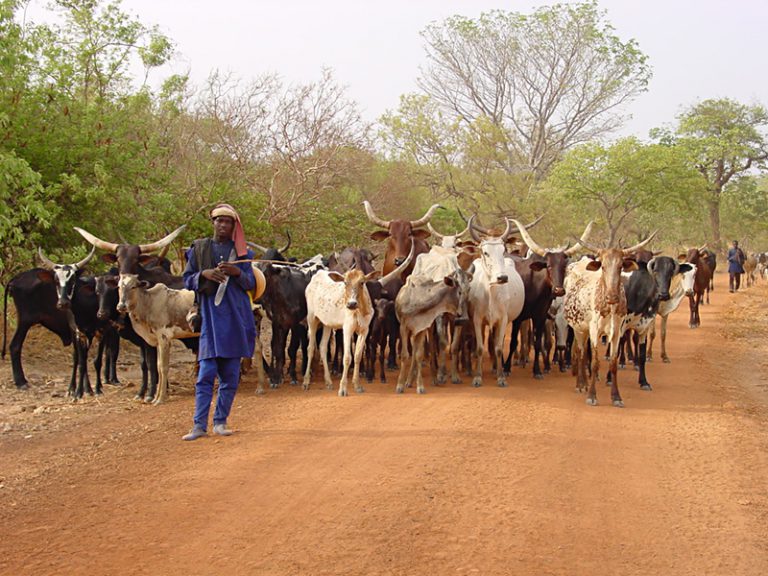A case study in sub-Saharan Africa
Pastoralism—a rural activity that prevails in dryland regions
As far back as Neolithic times, people in Africa and elsewhere in the world have specialized in pastoral livestock herding. The climate has meanwhile changed, and these herding peoples have been wandering in quest of suitable environments for their herds, while constantly adapting their lifestyle and production strategies to the new conditions they encounter. In addition to climatic variations, recent political and socioeconomic upheavals due to booming global population growth are affecting pastoral environments. Despite this, pastoralism is practiced to an increasing extent in some vast regions worldwide, especially in dryland areas where this activity is especially relevant. Livestock farmers in these areas use rearing techniques that are adapted to the scarce and spatiotemporally variable resources (especially fodder and water). These include:
- choosing and combining livestock species that are multipurpose, adapted to the environment (aridity, heat) and herding strategy (long-distance movements, difficult watering conditions, etc.);
- using diversified fodder: grasses, forage trees and shrubs (as supplement feed) and crop residue;
- promoting herd mobility, sometimes with the entire herding family involved.
Pastoralism has an important socioeconomic role, providing many goods and services for human societies: products of high market and nutritional value (milk, meat, leather, pelts), a source of energy (animal draught and transport), manure for crops, socioeconomic support (employment, mutual community aid, etc.), a savings instrument, etc.
A substantial number of people (1/6 of the population in some countries) live off pastoralism and an even higher number gain income throughout the commodity chain up to the consumer. Pastoralism thus contributes to food security in producing and importing countries. It enables the development of large tracts of land in these regions where otherwise there is little potential for economic development. The organization of pastoral societies is also an element of social stability and peace in dryland regions.
Vital herd mobility
Mobility is an adaptation strategy of herders to avoid the many threatening hazards. Due to marked differences in fodder availability over time at a given place in dryland areas, cattle must be capable of wandering constantly to find resources where they are available. In a single day, the distances travelled around a camp (small-scale mobility) vary depending on the season and the availability of water and fodder resources. Seasonal mobility (transhumance) involves a change of rangeland region in response to seasonal resource variations, whereby herders walk long distances (sometimes hundreds of kilometres) alongside their herds every year. The extent of herd mobility is never steadfast; it is flexible and fluctuates according to cyclical variables.
Threats to pastoralism in sub-Saharan regions and its adaptation capacity
The threats include recurrent drought, climate change, inappropriate policies, poverty due to livestock losses or to insufficient production and accumulation, increased competition between herders, agropastoralists and commercial crop farmers. The most long-standing challenge undoubtedly concerns the increase in agricultural activities in a high population growth setting without any increase in crop yields. Rangelands are often taken over to meet the need for new cropland. Moreover, for cropping purposes, private landowners are starting to take over lands that are not legally recognized as rangelands but which are conventionally regulated by common grazing rights. This phenomenon has a serious impact on pastoralism, with herders forced to make major adjustments to their herd wandering routes and schedules.
Current conditions for practicing pastoralism are increasingly difficult and complex. The future of this activity depends on the status allocated by each country and specific legislation.
Pastoralism still prevails, despite these threats, thanks to its high adaptation capacity:
- changes in strategies concerning movements into new areas (more humid southern regions);
- partial settling of families, thus securing home areas, with herds tended by shepherds;
- development and diversification of production systems (especially agriculture, in addition to pastoral livestock farming), activities and income;
- change in production techniques (herd composition, livestock species, partial herd settling);
- marketing of cattle and associated products.
Environmental footprint of pastoralism
Cattle interfere with natural ecological dynamics and have an impact on grazed ecosystems. Herd grazing modifies the ‘grasses-woody plant’ and ‘forage-nonforage’ species balance. Dung dispersal promotes the distribution of soil nutrients, water pollution, seed and pathogen dispersal. The impacts of carbon and greenhouse gas emission are considerable but have yet to be accurately assessed. Competition between domestic livestock and wildlife and the degradation of some habitats have effects on biodiversity. Moreover, some herding practices are environmentally detrimental, e.g. tree pruning which jeopardizes the flowering and fruiting process.
In many cases, however, degradation due to herding is the result of localized overgrazing or poor resource management, but the underlying causes must be assessed in order to be able to overcome them: poorly distributed watering sites, livestock mobility hampered by the loss of essential rangelands for other uses, etc.
Pastoralism also offers basic, yet not very evident, ecological services by contributing to the sustainability of natural and cultivated ecosystems. Rangelands are relatively natural environments since they spontaneously regenerate and have greater biodiversity than cultivated ecosystems.
Enhancing conditions for sustainable pastoralism
Combating desertification and protecting the environment in areas grazed by herders—by allowing them negotiated control of their resources, taking advantage of their technical know-how and boosting their knowledge—will enhance pastoral viability.
The natural mechanism for regulating the balance between resources and their use is strengthened by livestock herd mobility, thus avoiding rangeland degradation. Hampering this mobility increases the risk of desertification in drylands in the long term, e.g. by artificially maintaining a high permanent animal overstocking rate via massive feed inputs for cattle imported from other regions.
Considerable investment has long been focused on ensuring animal health (vaccinations, etc.) and strengthening livestock farming infrastructures (hydraulic structures, herd trails, etc.). This investment must be continued in order to improve herd distributions on rangelands and extension into agropastoral regions, as well as to increase production volumes and quality.
Living conditions of herding communities have not progressed concomitantly (education, health, security). This situation must be rectified. Integrated multisectoral development policies should also be developed in order to avoid or offset the socioeconomic impacts of climatic variations on the pastoral system by strengthening their adaptation capacities.
Decisions in favour of animal-based food production, rural farmers in marginal regions, the pastoral sector and the environment, in general, are primarily required on political, administrative and legal levels. It is essential to be attentive to herders’ needs and demands, to arbitrate conflicts of interest between pastoralism and other production sectors, and to invest in pastoralism. Authorities at all levels have the capacity to support pastoralism and contribute to maintaining and sustainably developing this invaluable economic activity in pastoral and agropastoral regions threatened by desertification.


